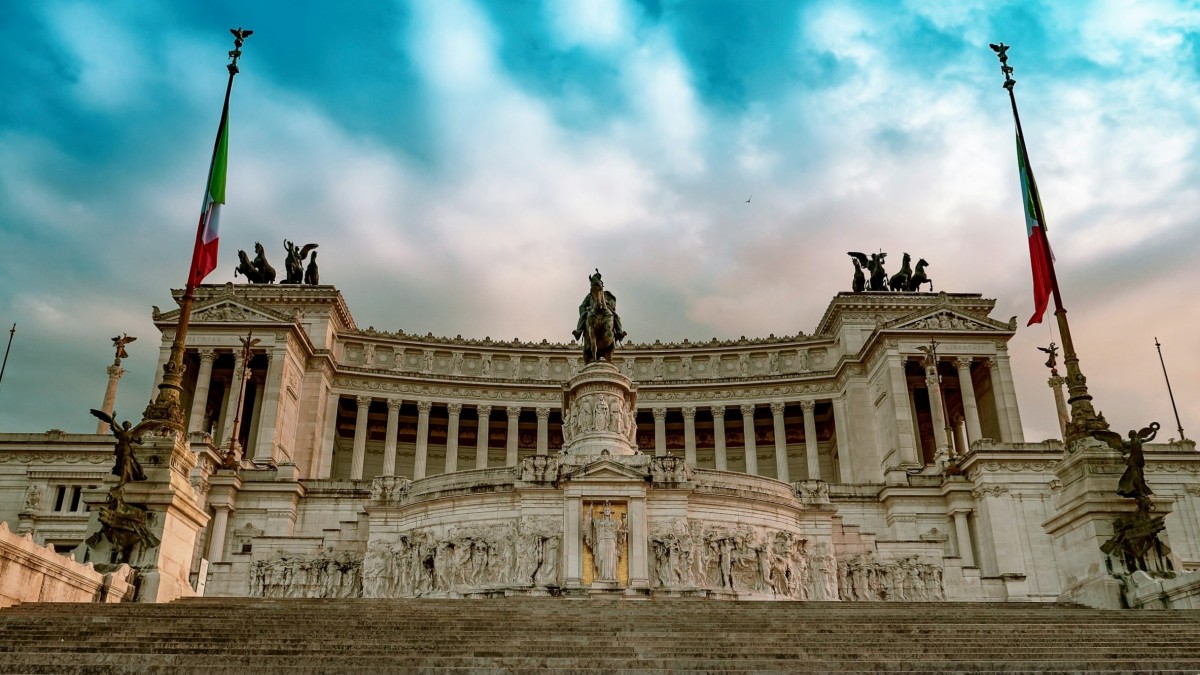
The Vittoriano, also known as the Monument to Victor Emmanuel II or the Altar of the Fatherland, is a national monument located in the heart of Rome, in Piazza Venezia. Dedicated to the first king of a united Italy, it stands as a symbol of national unity as well as democratic and European values. Its strategic position and imposing size make it one of the most recognisable landmarks in the Italian capital. But what exactly is the Vittoriano, and what is its history? This is everything you need to know.
Why was the Vittoriano built in Rome?
The monument was designed to commemorate Victor Emmanuel II, the first king of a united Italy, and to celebrate national unity. But when was it built, and who built it? Construction began in 1885 under the direction of architect Giuseppe Sacconi, who won the design competition. The choice of Piazza Venezia as the site was no coincidence: its central, strategic location allowed the monument to dominate Rome’s cityscape.
The Vittoriano – also known as the Altar of the Fatherland – is an extraordinary example of neoclassical architecture. Its striking white structure was built mainly from Botticino marble. The construction of the Vittoriano took several decades and involved numerous artists and craftsmen. It was officially inaugurated in 1911 during the celebrations for the 50th anniversary of Italian unification, although work continued until 1925.
What’s inside the Vittoriano?
The monument not only celebrates the unification of Italy but also serves as a place of remembrance for Italian soldiers who fell in war. Inside, you’ll find the Tomb of the Unknown Soldier – a powerful symbol of sacrifice and collective memory. Every year, the site becomes the focus of official ceremonies and national celebrations, including Italy’s Republic Day, held on 2 June.

The striking architecture of the Altar of the Fatherland
One of the most distinctive features of the Vittoriano is the vast staircase leading up to the Altar of the Fatherland. This staircase is not only a visually impressive architectural element but also symbolises a journey towards unity and freedom.
At the heart of the monument lies the memorial to the Unknown Soldier mentioned above, while the Vittoriano’s structure is further enriched with a series of decorative elements, including Corinthian columns, allegorical statues representing civic virtues, and bas-reliefs that depict the history and values of a united Italy.

Museums and temporary exhibitions at the Vittoriano
The Vittoriano Complex is also home to important cultural institutions that enrich Rome’s museum offering. Among them, there are a few that are particularly worth discovering.
- The Institute for the History of the Italian Risorgimento is dedicated to preserving and promoting the historical memory of Italy’s unification. Inside, visitors can explore a vast collection of documents, photographs and artefacts that tell the story of the Risorgimento – a pivotal period that led to the birth of modern Italy.
- The Shrine of the Flags of the Armed Forces houses a collection of historic flags, each symbolising the courage and sacrifice of Italian servicemen and women. Every flag tells a story of heroism and dedication.
- In addition to its permanent museums, the Vittoriano also features exhibition spaces that regularly host major temporary shows. These exhibitions cover a wide range of topics, from contemporary art to history, science and popular culture.

How to visit the Vittoriano Museum in Rome
To make the most of your visit, it’s helpful to know a few practical details that will help you maximise your time.
- Opening Hours: The Vittoriano is open every day from 9:30 AM to 7:30 PM, allowing you to explore its architectural and cultural wonders at your leisure.
- Tickets: The entrance fee is €18, which grants access to the Grand Portico, the Vittoriano’s Panoramic Terrace, the Central Museum of the Risorgimento, and Palazzo Venezia.
Staying close to the Vittoriano
In terms of accessibility, the Vittoriano is easily reachable thanks to its central location in Piazza Venezia. This strategic spot makes it an ideal starting point for exploring other nearby historic sites, such as the Roman Forum and the Colosseum. For those visiting Rome and looking for a holiday home, idealista's holiday rental website Rentalia offers a selection of comfortable and spacious accommodations.
